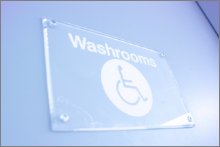Overactive Bladder: When is a Lot Too Much, What
are the Possible Causes and What Should You Do?
by www.SixWise.com
More than 17 million Americans suffer from overactive bladder,
according to the American Medical Women's Association. Though
it typically affects men that are over the age of 65, women
may start to experience symptoms in their mid-40s.
|

Overactive bladder is not just a physical problem.
It can lead to feelings of embarrassment, avoidance
of social situations and even low self-esteem and depression.
|
What exactly is overactive bladder? It stems from a problem
with bladder function that causes you to feel a strong, urgent
need to urinate. This can lead to incontinence, frequent urination
(eight or more times in 24 hours) and waking during the night
to urinate (usually two or more times).
Aside from the physical symptoms, overactive bladder can
interfere with your daily life, making it difficult to attend
social situations, and can even result in depression, low
self-esteem, fatigue and anxiety.
What Causes Overactive Bladder?
In a healthy bladder, nerve signals let you know your bladder
is "full" when it's reached about half its capacity,
and you feel you need to urinate when it's about three-quarters
full.
With overactive bladder, however, bladder muscles contract
or spasm involuntarily when the bladder is only about half
full. The contractions cause you to feel an urgent need to
urinate, even though your bladder is not yet full.
While certain conditions, such as Parkinson's disease and
strokes, are associated with overactive bladder, other conditions
can cause similar symptoms, according to the Mayo Clinic,
including:
-
Urinary tract infection
-
Diabetes
-
Tissue inflammation near the urinary tract
-
Tumors or other abnormalities in the bladder
-
Enlarged prostate, constipation, bladder stones and other factors that obstruct
bladder outflow
-
Drinking excessive amounts of caffeine or alcohol
Certain medications can also contribute to incontinence.
Diuretics, sedatives, muscles relaxants, narcotics, antihistamines,
anticholinergics, antipsychotics, antidepressants
and calcium channel blockers are particularly problematic
for incontinence, according to the National Association for
Continence (NAFC).
|

Women are more likely to experience overactive bladder
than men.
|
What to do if You Have Overactive Bladder
Overactive bladder is more common in older adults, but it
is not a "normal"
part of aging. If you have some of the symptoms of overactive
bladder, you should see your doctor to rule out any associated
or underlying problems.
While there are prescription drugs out there for overactive
bladder, they do have side effects such as dry mouth, constipation,
blurred vision, and memory problems. Fortunately, there are
many non-drug methods you can use to help treat the condition.
These include:
-
Eat a high-fiber
diet. This is important to help you avoid constipation
(and is great for your overall health, too).
-
Exercise regularly. It's an important part of
every healthy lifestyle.
-
Limit your consumption of caffeine and alcohol,
which can trigger or worsen symptoms.
-
Look for dietary triggers. Certain foods can irritate
the bladder in some people. Common irritants include carbonated
beverages, sugar, artificial sweeteners, spicy foods,
citrus juice, tomatoes, corn syrup and milk.
-
Monitor your fluid consumption. Sometimes limiting
the amount of fluid you drink before bedtime or before
attending a social event can help.
-
Kegel exercises. Kegels strengthen the pelvic
floor muscles and urinary sphincter, according to the
Mayo Clinic, which help you to hold urine. These exercises
can also help to suppress involuntary contractions in
the bladder. Kegel
exercises involve squeezing your pelvic floor muscles
at least three times a day. A physical therapist or your
doctor can tell you how to do them correctly.
-
Maintain a healthy weight. Excess weight puts
stress on the bladder and increases the risk of incontinence.
-
Don't use feminine deodorant products, which may
irritate the urethra.
-
Don't smoke. Smokers are more likely to have problems
with incontinence than non-smokers.
-
Bladder training. Your doctor may recommend "retraining"
your bladder by gradually delaying urination when you
feel the urge to go.
Finally, if an overactive bladder is holding you back from
professional or social functions, consider wearing an absorbent
pad so you don't have to worry if you do experience incontinence.
Recommended Reading
Getting
Past Passing Gas: How to Reduce or Eliminate the Problem No
One Discusses, Flatulence
The
Six Worst Lifestyle Choices You Could Make
Sources
National Association
for Continence
MayoClinic.com
American
Medical Women's Association
DrWeil.com